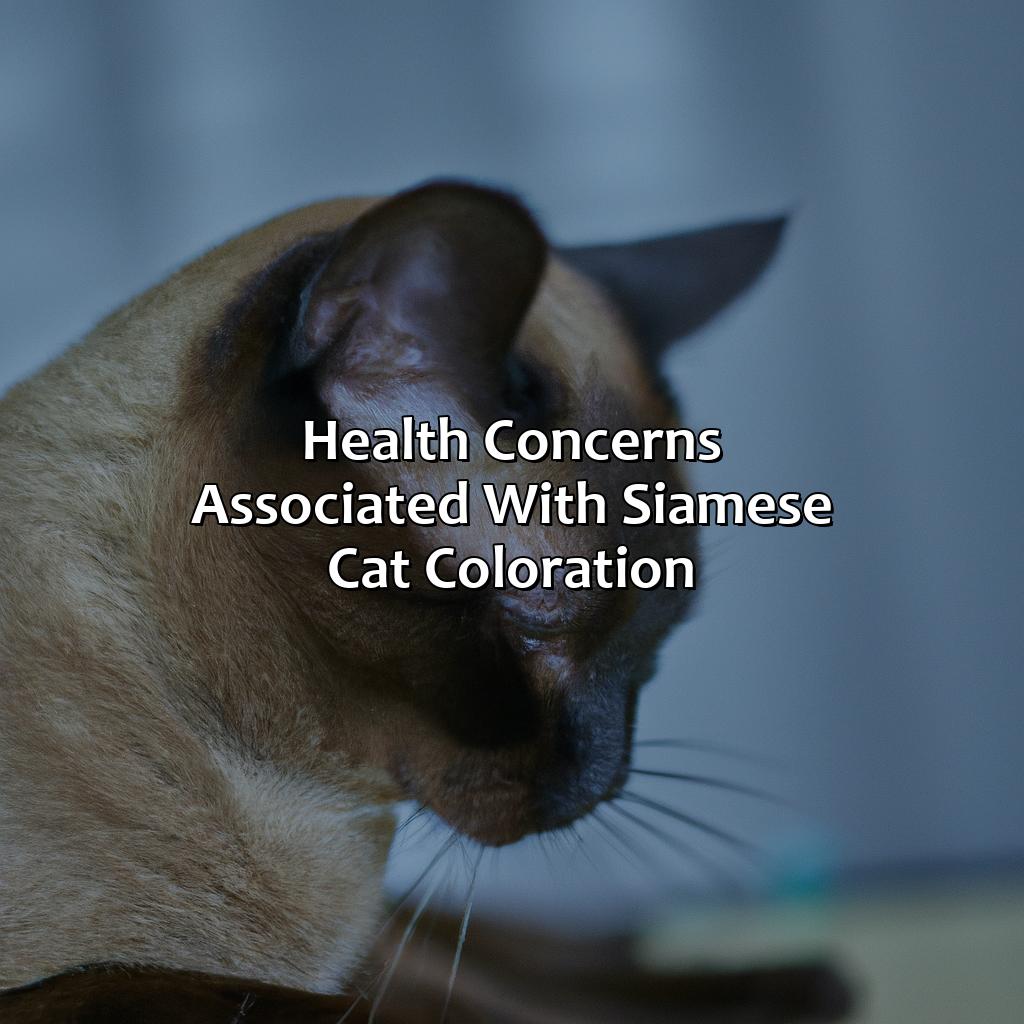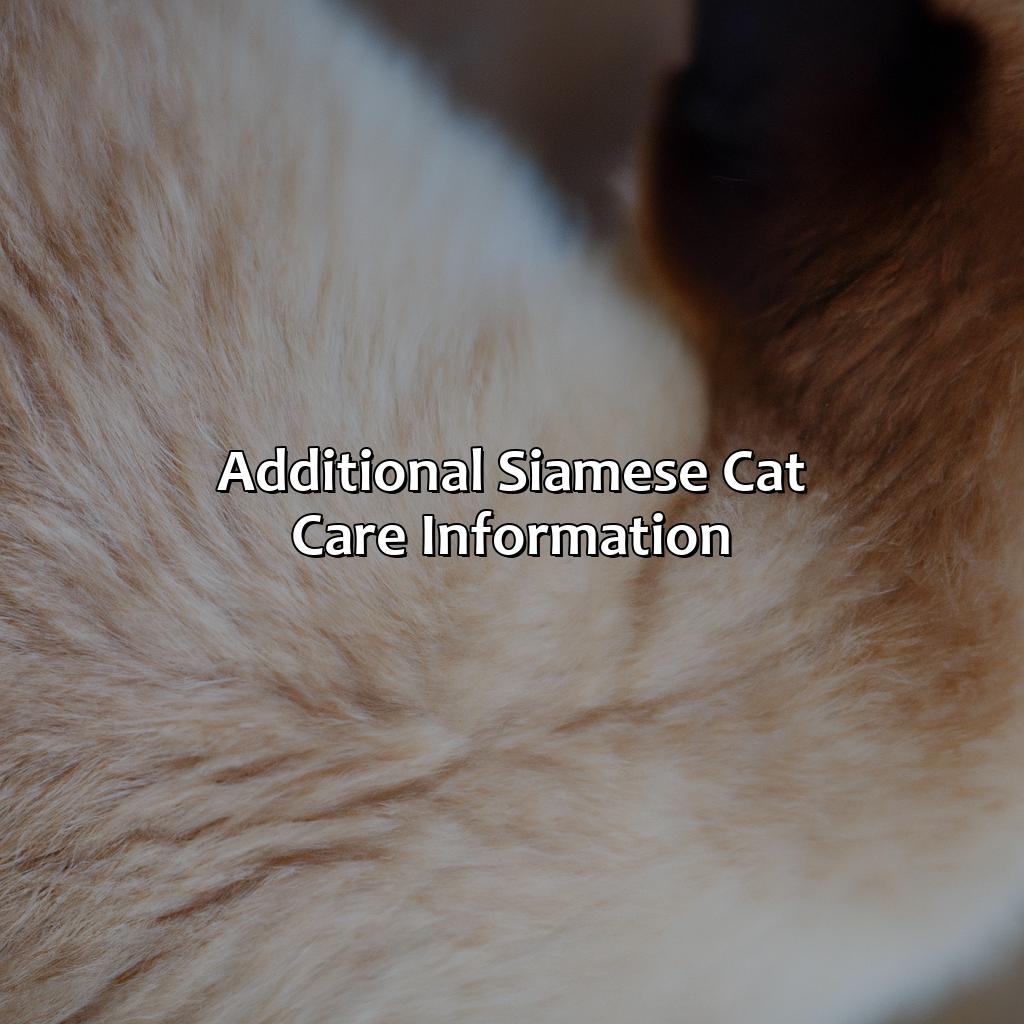Key Takeaway:
- Siamese cats have a distinctive pointed pattern in their coats, with darker coloration on their faces, ears, paws, and tails.
- Snowshoe Siamese cats have a unique coat variation with white feet, while tortie point and lynx point Siamese have additional color variations in their coats.
- Breeding Siamese cats for specific coat coloration involves understanding color genetics and breed standards, but also requires considering potential health concerns associated with certain color variations.
Physical Characteristics of Siamese Cats

Photo Credits: colorscombo.com by George Gonzalez
Siamese cats are well-known for their distinctive characteristics, including their sleek bodies, vivid blue eyes, and distinctive coloring. As a breed, their feline anatomy is graceful and athletic, with long, slim legs and a muscular build that allows them to move with agility. Thai cats are known for being talkative and friendly, which is consistent with breed standards. Additionally, the breed is known for its intelligence and desire for attention and affection, making them a popular choice among cat lovers. A rich and colorful history surrounds the Siamese cat breed, with anecdotes dating back several centuries. These anecdotes often center around their unique vocalizations, which were believed to mirror the tones and inflections of the human voice.
Coat Color and Patterns of Siamese Cats

Photo Credits: colorscombo.com by Keith Young
Siamese cats are known for their unique coat color and patterns. They exhibit a pointed pattern, which means that they have a lighter coat color on their bodies and a darker color on their extremities. The coloration of the Siamese cat is determined by its color genetics.
To understand the different coat variations of Siamese cats, consider the following table:
| Color Points | Description |
|---|---|
| Seal Point | Dark brown on extremities and face with light brown or cream colored body |
| Blue Point | Gray on extremities and face with white or cream-colored body |
| Chocolate Point | Muted brown on extremities and face with cream-colored body |
| Lilac Point | Lavender or pinkish gray on extremities and face with white or cream-colored body |
| Red Point | Orange-red on extremities and face with cream-colored body |
| Cream Point | Cream color on extremities and face with cream-colored body |
| Tortie Point | Seal or chocolate color with red or cream mixed in |
| Lynx Point | Tabby striping on extremities and face with lighter-colored body |
| Tabby Point | Darker tabby stripes on extremities and face with lighter-colored body |
| Snowshoe Cats | White body with colored points on extremities and face |
It is interesting to note that the tortie point and lynx point variations are not traditional pointed patterns but rather variations that add striping or mixed colors to the cat’s coat.
Pro Tip: If you are considering adopting a Siamese cat, it is important to research the breed’s color genetics to understand potential coat variations and which color points you prefer.
Eye Color of Siamese Cats

Photo Credits: colorscombo.com by Stephen Smith
Siamese cats are well known for their distinctive blue eyes. This breed is visually stunning, with a slender body and strikingly colored coat. Their eye color is a defining characteristic, making them popular pets among cat lovers. The blue eyes of Siamese cats are a result of a genetic mutation that limits the production of melanin in their irises. This mutation is linked to the breed’s origins in Thailand, where it is believed that these felines were kept as sacred animals. Along with their stunning blue eyes, Siamese cats also have almond-shaped, bright blue eyes, which add to their beauty. In fact, their eyes are so captivating that they have been used in several movies as a defining feature of the breed. A true fact is that Siamese cats appeared in the Disney movie “The Lady and the Tramp” and were portrayed with their signature blue eyes.
Popular Siamese Color Variations

Photo Credits: colorscombo.com by Alan Lopez
Siamese cats are known for their distinct color variations. These variations include seal point, chocolate point, blue point, lilac point, flame point, and red point. Here’s a breakdown of some of the most popular color variations:
- Seal Point: This variation features a dark brown or black body with darker ears, tail, and face. The paws are typically a lighter shade of brown.
- Chocolate Point: These cats have a lighter brown body with darker brown feet, tail, and face.
- Blue Point: Blue Point Siamese cats have bluish-gray bodies with darker gray features on their face, ears, tail, and feet.
- Lilac Point: This variation features a light grayish-brown body with pinkish-gray feet, tail, and face.
- Flame Point: Flame Point Siamese cats have a cream-colored body with reddish-orange features on their face, ears, tail, and feet.
- Red Point: These cats have a pale orange body with darker orange features on their face, ears, tail, and feet.
Unique elements of Siamese cat color variations include their varying body colors, as well as the distinct color points on their face, ears, tail, and feet. It’s important to note that each Siamese cat’s individual coloration can vary, making them unique from one another.
Pro Tip: When purchasing a Siamese cat, consider their individual coloring and whether it fits your personal preferences and lifestyle. Additionally, be sure to invest in high-quality food to maintain their unique coat coloring.
Breeding Siamese Cats for Specific Coloration

Photo Credits: colorscombo.com by Ryan Perez
Breeding Siamese cats to achieve specific coloration is a process based on color genetics. The goal is to produce cats with distinctive coat patterns and colors, and breeders achieve this by selectively breeding cats with desired color variations. In this process, the primary focus is on recessive genes that produce distinctive colorations.
Below is a table demonstrating the breeders’ focus on recessive genes when breeding Siamese cats for specific coloration.
| Gene | Dominant | Recessive |
|---|---|---|
| Hair | Short | Long |
| Color | Colorpoint (dark ears, tail, and paws, light grey body) | Non-point (solid color) |
| Eye Color | Blue | Green or Yellow |
| Coat Patterns | Tortie, Lynx, Bicolour | Solid Color |
Some of the unique details about breeding Siamese cats include using DNA testing to determine a breeding cat’s genotype and designing breeding plans. These plans must factor in the cats’ pedigree and potential offspring’s coat coloration outcomes.
For successful breeding, it is essential to select cats from different bloodlines to avoid inbreeding. Additionally, breeders should test for genetic diseases and choose cats with negative results.
To ensure the health and welfare of cats, breeders, and owners, it is vital to research cat breeds’ color genetics before breeding. This can help breeders avoid potential genetic issues that can occur when breeding cats with similar color genetics repeatedly.
Health Concerns Associated with Siamese Cat Coloration

Photo Credits: colorscombo.com by Vincent Garcia
Siamese cat coloration may be aesthetically pleasing, but it also poses certain health concerns that should not be ignored. These cats may be prone to certain types of cancer, particularly squamous cell carcinoma, which is associated with lighter fur. Additionally, Siamese cats with darker fur may be more susceptible to respiratory issues due to the pigment in their fur. It is important to keep these factors in mind when considering the health and wellbeing of your Siamese cat.
Taking preventative measures such as providing adequate sun protection for lighter colored cats and regular respiratory check-ups for darker colored cats may help in reducing health risks. As with any cat, it is important to stay vigilant for any changes in behavior or health and seek vet care as needed.
When it comes to cat health, it is important to keep in mind that not all cats are hypoallergenic. While some breeds may be less allergenic, there is no such thing as a completely hypoallergenic cat. It is important to consider this when choosing a cat, particularly if you or someone in your household suffers from allergies.
To ensure the health and wellbeing of your Siamese cat, it is important to stay aware of potential health concerns and take proactive steps to address them. By staying informed and attentive, you can help give your furry friend a happy and healthy life.
Additional Siamese Cat Care Information

Photo Credits: colorscombo.com by Brian Rodriguez
Siamese cats are known for their uniquely attractive appearance and intelligent personalities. To provide the best pet care for your Siamese cat, it is essential to understand their specific nutrition, grooming, and training needs.
Proper cat nutrition is crucial, as a balanced diet can help prevent health issues and promote their well-being. Additionally, regular grooming, such as brushing their coat and teeth, can help prevent cat behavior problems and maintain their hygiene. Providing Siamese cats with engaging cat toys and suitable cat accessories can help them stay active and mentally stimulated.
As with any cat breed, it is important to be aware of common cat diseases and to schedule regular cat vaccination appointments. Consider spaying or neutering your Siamese cat to prevent unwanted litters and reduce the risk of certain cat health issues. Siamese cat rescue organizations are also available to support the adoption and care of these beloved cats. Understanding the Siamese cat breed characteristics, including their personality traits and history and origin, can help provide a fulfilling cat care experience.
Five Facts About Siamese Cats:
- ✅ Siamese cats are one of the oldest breeds of domesticated cats, originating from Thailand (formerly known as Siam). (Source: The Cat Fanciers’ Association)
- ✅ Siamese cats are known for their distinctive coat pattern, which is called “points.” (Source: Vet Street)
- ✅ Siamese cats are very vocal and can communicate through various meows, chirps, and yowls. (Source: Purina)
- ✅ Siamese cats are known for their intelligence and can be trained to do tricks and even walk on a leash. (Source: The Spruce Pets)
- ✅ Siamese cats have a long life expectancy, with an average lifespan of 12-15 years. (Source: Hill’s Pet Nutrition)
FAQs about What Color Are Siamese Cats
What color are Siamese cats?
Siamese cats are known for their distinctive coloring, which typically features a light-colored body and darker points on their faces, ears, paws, and tails. The coloring can vary from light cream to a deep brownish-black, known as seal point.
What other colors do Siamese cats come in?
While seal point is the most common color for Siamese cats, they can also come in several other point colors, including blue point (grayish blue), chocolate point (brown), and lilac point (pinkish gray).
Do Siamese cats change color as they age?
Yes, Siamese cats often darken as they age, although the extent of the change can vary. This is because the color of their points is determined by the temperature of the skin, which can change as a cat grows older.
What about the body color of Siamese cats?
The body color of Siamese cats is typically a light cream or ivory color, although some Siamese cats can have a bluish-gray or silver body color. The body color should provide a good contrast to the darker points.
Are Siamese cats hypoallergenic?
No, Siamese cats are not hypoallergenic. They have short, fine fur that sheds moderately, so they may not be the best choice for people with severe allergies to cats.
Can Siamese cats have white spots or markings on their bodies?
While it is rare, Siamese cats can sometimes have small white markings on their bodies. However, these white markings are not recognized in the breed standard and are considered a fault in show cats.






